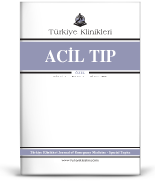Aslında, toksikoloji terimi, Yunanca toxikos (''yay'') ve toxikon (''ok uçlarının batırıldığı zehir'') terimlerinden türetilmiştir. ''Zehir olmayan ne var ki'' Her şey zehirdir ve zehirsiz hiçbir şey yoktur. Yalnızca doz, bir şeyin zehir olmadığını belirler.'' Sözleri Paracelsus'a aittir. Toksikoloji tarihinde önemli bir tespittir. Günümüz tıbbında her ne sebeple olursa olsun zehirlenen ya da zehirlendiği düşünülen her hastanın ilk adresi acil servislerdir. Toksikoloji hastasında hastayı ve semptomlarını tanımak kadar, alınan maddeyi de tanımak tedavinin en önemli parçasıdır.
Acil tıp pratiğinde zehirlenen hastalar çoğu kez şuuru kapalı olarak getirilir. Hangi tür bir madde ile zehirlendiği bilinemez. Hatta çoğu kez zehirlendiği bile belli değildir. Bu hastaların teşhis ve tedavisinde anamnez, fizik muayene bulguları, laboratuvar verileri ve doktorun klinik tecrübeleri önemlidir. Ancak doktorun bir zehirlenme durumundan şüphelenmesi, bazen en önemli tanı aracıdır. Yoksa bu hastalar ne yazık ki kaybedilir.
Klasik hekimlik pratiğinde bir hastayı klinik olarak çözümlemede ''Semptomdan Teşhise, Teşhisten Tedaviye'' gidilir. Ancak zehirlenme hastalarında bu sıra her zaman geçerli değildir. Bu hastalarda çoğu kez ''Semptomdan Tedaviye'' geçmek gerekir. Bu hastalara her zaman teşhis koyamayabilirsiniz. Ya da zehirlenmeye neden olan etkin maddeyi tam olarak belirleyemeyebilirsiniz.
İşte bu noktada tanı olmadan ''Semptomdan Teşhise'' geçebilmek için ''Toksidromlar/Toksik Sendromlar'' tanımlanmıştır. Şayet bu toksik sendromlar iyi bilinir, hasta doğru yönetilirse kısa sürede tedavi başarıya ulaşır ve hasta sağlığına kavuşur.
Bir süredir ülkenin saygın yayıncı kuruluşu olan Türkiye Klinikleri, acil tıp özel konular serisi çıkarıyor. Bu seri ile acil tıp camiası birçok konuda güncel ve Türkçe bilgilere ulaşabiliyor. Bu kitapta ''Toksidromlar/Toksik Sendromlar'' konusunu ayrıntılı bir şekilde yazmaya çalıştık. Bu kitabın öncelikli hedef kitlesi acil tıp uzmanları ve acil tıp asistanlarıdır. Ancak zehirlenme hastası bakan pratisyen hekimler, diğer uzmanlar, yoğun bakım ekipleri, paramedik ve hemşireler de bu kaynaktan faydalanabilirler
Bu kitaba Gaziantep Üniversitesi Tıp Fakültesi Acil Tıp Anabilim Dalı, Klinik Toksikoloji Bilim Dalı olarak öncülük etmek istedik. Sağlık bilimleri enstitüsü bünyesinde kurulan ve Acil Tıp Anabilim Dalının yürüttüğü ''Klinik Toksikoloji Bilim Dalı'' öğretim üyeleri ve öğrencileri çoğunluk olarak bu kitaba katkı verdiler. Ayrıca toksikolojiye gönül veren çok kıymetli bazı öğretim üyeleri de bu kitaba katkı sağladılar. Bu kitap bize gösterdi ki ''Klinik Toksikoloji'' yan dalı acil tıp uzmanlığına çok yakışacak.
Kitabın hazırlanmasında emeği geçen tüm bilim insanı akademisyen arkadaşlarımı candan kutlarım. Acil tıp camiasına her koşulda destek veren Türkiye Klinikleri ailesine de ayrıca şükranlarımı sunarım.
İyi okumalar...
Prof. Dr. Cuma YILDIRIM
Editör
In fact, the term toxicology is derived from the Greek terms toxicos (''bow'') and toxicon (''poison into which arrowheads are dipped''). ''What is not poison'' Everything is poison and there is nothing without poison. Quantity is what determines whether something is a poison or not.'' The words belong to Paracelsus. It is an important finding in the history of toxicology.
In the modern medicine, all patients who have died or are thought to be dying for whatever reason are the first to be called to the emergency service. The most crucial part of treatment is to recognize the substance that was taken, and to recognize the patient's symptoms in poisoned patients. The patients affected by poison are typically presented at the emergency clinic in an unconscious state. The type of poison the patient was exposed to is unknown. It is not even clear that the patient is usually poisoned. The history of the patient, physical examination findings, laboratory data, and clinical experience of the physicians are important in the diagnosis and treatment of these patients. However, the doctor's suspicion of a poisoning situation is sometimes the most important diagnostic tool. Failing to act, these patients may unfortunately die.
In the classical medical practice, 'from symptom to diagnosis, from diagnosis to treatment' is used to analyze a patient clinically. Nonetheless, this protocol may not be sufficient in cases of patient poisoning. In these circumstances, it is often necessary to switch from 'Symptom to Treatment'. You may not always be able to diagnose these patients or you may not be able to identify the active substance causing the poisoning exactly. At this point the term ''toxidromes/toxic syndromes'' was defined to be able to replace symptom to diagnosis without a diagnosis of the disease. If these toxic syndromes are well known and the patient is managed properly, the treatment will be successful in a short time and the patient will be restored to full health.
Türkiye Klinikleri, a respected publisher of Türkiye, has published a number of special topics series of emergency medicine for some time. With this series, the emergency medicine community can access up-to-date and Turkish information on many subjects. In this book, we tried to write the topic of ''Toxidromes/Toxic Syndromes'' in detail. The primary target audience of this special issue is emergency medicine physicians and residents. However, general practitioners, other specialists, intensive care teams, paramedics and nurses who care for poisoning patients can also benefit from this resource.
We wanted to lead this book as Gaziantep University Faculty of Medicine, Department of Emergency Medicine, and Division of Clinical Toxicology. The faculty members and students of the ''Clinical Toxicology Department'', which was established within the Health Sciences Institute and carried out by the Emergency Medicine Department, contributed to this book as the majority. In addition, some very valuable faculty members who devoted themselves to toxicology contributed to this book. The book demonstrated that emergency medicine physicians would benefit greatly from having a ''Clinical Toxicology'' sub-specialist.
I extend my warmest congratulations to my esteemed colleagues in the scientific and academic communities who participated in the book's development. I would also like to express my gratitude to the Türkiye Klinikleri family for supporting the emergency medicine community in all situations.
Good reading...
Prof. Dr. Cuma YILDIRIM
Editor







.: Process List